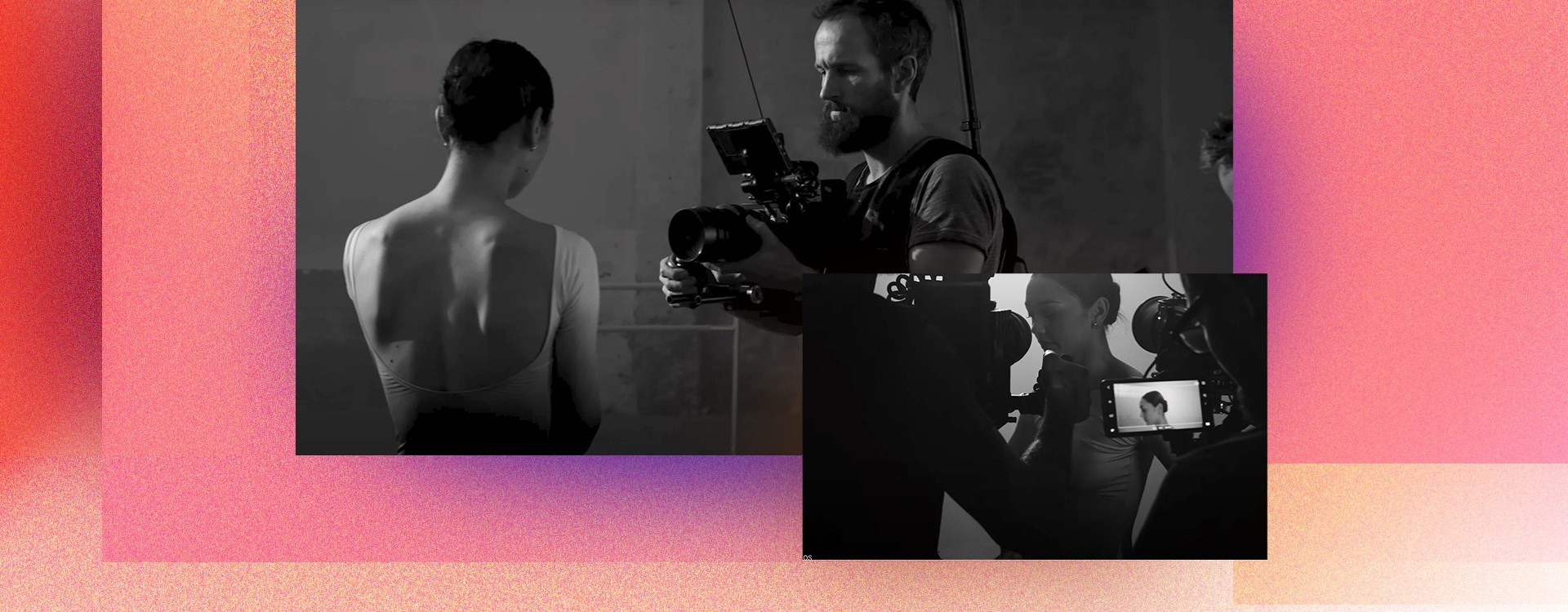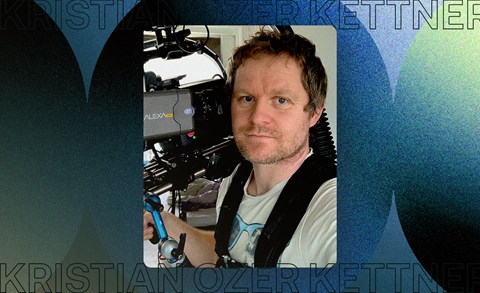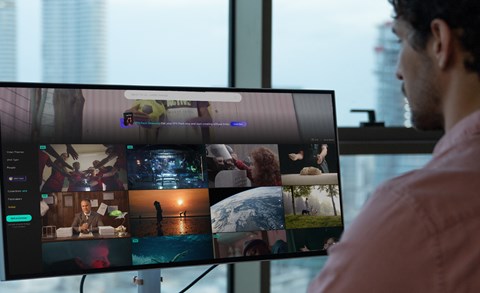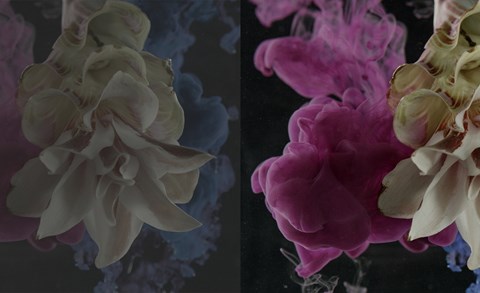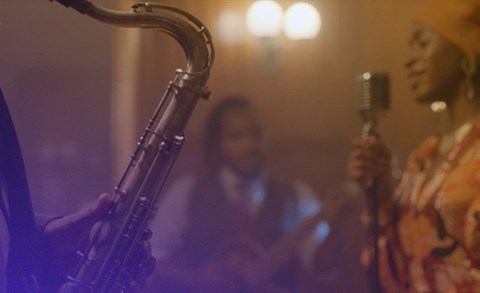Hans Peter Schepp is an Amsterdam-based filmmaker whose subtle and universal style has made him a favorite amongst Artlist users. Today he gives us a glimpse behind the scenes of his recent shoot of one of his most remarkable Artgrid stories - Female Dancer. Along the way, he shares the secret to creating moving imagery that's emotive, compassionate and universal.
Harness your location
"This production was meant to explore the intricacies and complexities of dance in a unique way. This film represents the reality of life dancing and explores the dancers' grueling practice schedule, injuries and self-criticism. The location needed to reinforce this message, so we filmed in an old ammunition factory in the Netherlands. It was the dead of winter, and a snowstorm was threatening to break outside. We removed all furniture and props to give the dancer space to unearth her own story, ensuring the starkness of the set mirrored the starkness of our subject. We stripped back the story of this dancer - and many dancers - to the very bones, revealing the pain, anguish, euphoria and joy that comes with a life dedicated to dance.
Leave your ego at the door
Shoots like this are punishing. It was freezing cold, we had a time limit, and we didn't know if the whole thing would be ruined by snow. Everyone was feeling this discomfort and pressure, which is why it's so important that I, as the filmmaker, step back and make sure everyone feels included and seen. We were lucky enough to be working with a dancer called Nancy Burer, who dances for one of the top dance companies in the Netherlands, the Dutch National Ballet. Although I had many ideas for the choreography of the shoot, it was crucial I let Nancy lead. After all, she is a world-class professional, and I've never even tried a Samba class. Giving Nancy the space to express herself filled the shoot with emotion and feeling. You can't hear music in the footage, but we asked Nancy to play her favorite tracks and dance in a way that's totally personal to her.
Shoots like this are about sensitivity. I don't push my ideas because the subject's wants and needs are more important than my expectations. Instead, I try to keep my energy humble and inclusive and encourage the entire crew to contribute. I feel that to be successful in the world of film, you need to create a nurturing, inclusive environment. That means people will want to work with you, and you'll get the best out of them.
Nature is always changing
We knew we wanted the sun to shine in through the window to create this stark contrast between light and dark. However, the day was overcast, and even if it hadn't been, we'd have enjoyed the light for about 10 minutes before it moved on. So we hiked an Arri M25 HMI unit with a Fresnel light onto the roof of the warehouse to shine through the window and create that raw, wintery, vintage light.
We did something very similar for the Male Dancer shoot, although this was shot in a studio. I used lighting equipment to create dark contrasts and shadows to emphasize the dancer's facial expressions and add depth to the piece. Shoots like these are so simple; it's the light that brings it to life. In both shoots, I used light to represent our internal and external worlds - the yin and the yang, the profound contradictions in everyday life and the thin line between pleasure and pain.
Play with extremes
The female dancer's shoot was all about extremes, and I used lenses and angles to reflect this. In a space as big as the warehouse we shot in, it's important to go very wide, and there's a still image of me hunched in a corner like a Hobbit trying to get a shot of the entire space.

10 minutes later, I'm right up next to the dancer with a macro lens getting intricate details.
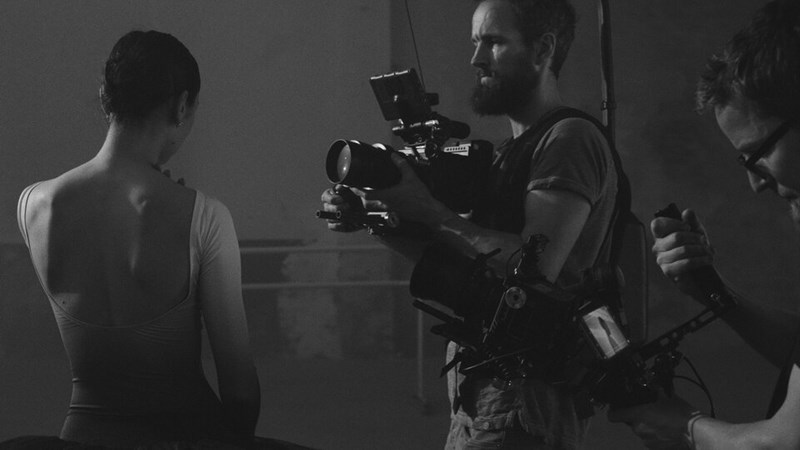
I like to use extremes - I feel it invites the viewer into the space. One of the major challenges and critical roles of a cinematographer is to give the viewer a sense of being there and create logic within a space. So I use a wide range of lenses, from wide-angle lenses to macro through prime and standard lenses and other capturing tools to invite the viewer in.
Get to know your subject
It's crucial to give your subject freedom of expression when shooting a medium like dance, so meet with your dancer before you begin shooting to establish a relationship. Ask them what space they need, their requirements, what would make their day difficult and what makes their day shine. I need to find out what they need to do their job. Go and see them dance to understand what type of camera motion you need. Get in tune with them to establish how you can best work together. Then they'll allow you into their private world so you and the viewer can truly get to know them. Filmmakers are often part psychologists.
For more insight, check out our blog post about filming dance.
Ride or die
Crew is everything, and the way you treat them is crucial for your success as a filmmaker. Most of the people I work with have been with me a long time, although I love to work with newbies too. In filmmaking, the crew should be viewed as family. Our budget wasn't huge for this shoot, so we had about 10 people on set filling different roles. For my crew, I like to select people who are happy to switch roles and aren't too proud to jump in and help with small tasks. It's also important for me to be flexible and build an open and inclusive space where everyone feels like an equally valued member of the team, regardless of pay grade or experience.
Uniting the arts
Filming the Female Dancer shoot was both mentally and physically exhausting. There were so many challenging factors - weather, time limits, lighting, camera angles - and if the entire crew weren’t on board to help with all aspects I wouldn’t have captured the results I wanted.
Working with Nancy reminded me of the beauty of uniting the arts, and this merging of dance and motion picture was a collaborative effort. Nancy was very motivated to work with us on the story and I feel her input, narrative and emotions shine through the final cut.
When I contacted Nancy to get her thoughts on how the shoot went, she said, 'For Me, this video was a new level of filming. The people, the atmosphere, the location, it all came together because we understood each other so well. It will always have a special place in my heart.'"
To see more of Hans' work, check out his page on Artgrid.
Technical details for the Female Dancer shoot
Cameras & lenses
Red Epic-x Dragon 6K Handheld + Easyrig
Red Komodo 6K + CANON 0.71x Speedbooster
Zeiss 18mm Distagon, 28, 55, 85 Otus
Zeiss 25, 35, 50 Milvus
Macro Diopter 2.6x Century Precision Optics
Gimbal DJI Ronin RS2
Lighting & grip
3x Pavotube RGB LED Tube for overhead edge light on close-ups.
Arri HMI M25 + 6.10M 4stage Tripod + Frames for Roof montage
Aputure 300D with spotlight/ Aputure 120D (Edge)
Aputure Nova 300C
2x Arri 650watt for light shapes on the wall
Large Silver Bounce
Large Negative Fill
Skylite Rapid Reflector large with Black / Silver / White for either bounce or negative fill
Chimera Lighting PANEL - FRAME - 48" X 48" + diffusion/Gel Frame 1X1 m.
Fog Machine
About Alice
Alice Austin is a freelance writer from London. She writes for Mixmag, Beatportal, Huck, Dummy, Electronic Beats, Red Bulletin and more. She likes to explore youth and sub-culture through the lens of music, a vocation that has led her around the world. You can contact and/or follow her on Twitter and Instagram.
